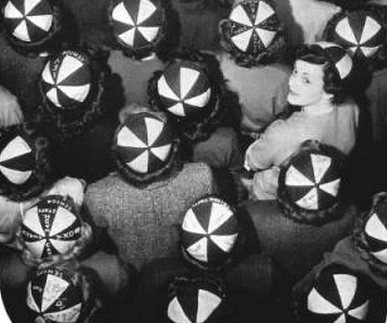It’s 1953 and Stephens College has a new president.
It’s not clear, however, where President Homer Rainey has
gone. His official biography doesn't pick up again until 1956 when he joined the University
of Colorado faculty. There is no mention of Rainey in the 1953
Stephensophia. The official Homer P. Rainey Papers indicate there had been some concerns about
Rainey’s political affiliations.
 His replacement is Thomas Spragens, a Kentucky native who has
worked at the U.S. Bureau of the Budget, the Foreign Economic Administration
and as an assistant to the president at Stanford University. Compared to his
predecessors, he’s a young man, and he and his wife have three small children.
His replacement is Thomas Spragens, a Kentucky native who has
worked at the U.S. Bureau of the Budget, the Foreign Economic Administration
and as an assistant to the president at Stanford University. Compared to his
predecessors, he’s a young man, and he and his wife have three small children.
The 1953 Stephensophia is dedicated to Frank W. Dearing, a
master builder. We’re told he came to campus in 1922 when Stephens was a single
plot of land.
Stephens is as active as ever with a club for most majors
and hobbies. The World Citizenship Organization this year held a mock
presidential election, and a campus-wide carnival included “barkers,”
sideshows, guessing games, fortune tellers and dart-throwing.
The Division of Occupations, which oversees the aviation,
business and fashion programs, is growing in popularity. We’re told since the
“outbreak of World War II, a greater number of women have been working than
ever before. With the accelerated need for women, Stephens has adjusted its
programing to these changing needs of society.” Today, we call that the
Stephens method—we continue to add and adjust programming around actual
industry needs.
There’s also a new course called Women in Community
Leadership that brings in guest instructors—women who have made outstanding
contributions in public affairs.
Another campus guest this year is Margaret Bourke-White, the
famous Life reporter who is just back from Korea this year. Bourke-White was
the first female war correspondent and the first foreign photographer allowed
to take photographs of Soviet industry.
Students also had a chance to travel the world again this
year, taking Stephens-sponsored trips to Mexico, Jamaica and throughout the
U.S. The Concert Chorus also toured Indiana and Kentucky as well as visiting
the Rolla School of Mines—now the Missouri University of Science &
Technology.
This year, the Standing Ideals Committee is charged with
promoting Stephens’ Ten Ideals, including creating and hanging posters around
campus—a practice still observed by our graphic design students today.
This
year, however, a single student is not assigned to represent each Ideal—or if
they were, they’re not photographed in the yearbook as in past years. This
year, the
Stephensophia uses images from campus to represent the Ideals. Here
are a few:
 Among this year’s class is Joan Mell, Civic Association
president. Mell would go on to the Joan Mell Lansche, a founding member of a
foundation dedicated to protecting the watershed of the Henry’s Fork on Snake
River. She also was known for assisting breast cancer survivors.
Among this year’s class is Joan Mell, Civic Association
president. Mell would go on to the Joan Mell Lansche, a founding member of a
foundation dedicated to protecting the watershed of the Henry’s Fork on Snake
River. She also was known for assisting breast cancer survivors.
Burrall Cabinet is headed by Dorothy Figel, now Dr. Dorothy
Figel Buckner, a psychiatrist in Georgia.
And Gretel Sternberg, a member of the Aviation Club and the Council of Hall Managers, went on to be a special representative to the president of National Airlines. Gretel Coursol, as she’s known today, has worked in a number or other roles, as well. We found her on YouTube, where she posted this wonderful footage of the 1953 Stephens Commencement. Enjoy.
And Gretel Sternberg, a member of the Aviation Club and the Council of Hall Managers, went on to be a special representative to the president of National Airlines. Gretel Coursol, as she’s known today, has worked in a number or other roles, as well. We found her on YouTube, where she posted this wonderful footage of the 1953 Stephens Commencement. Enjoy.





























